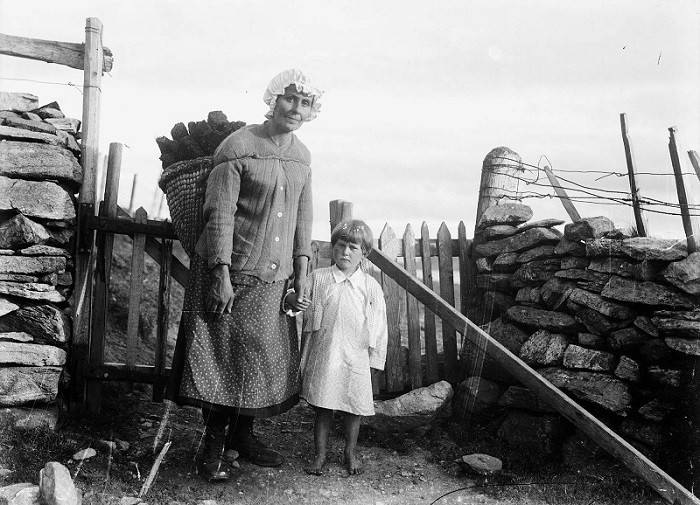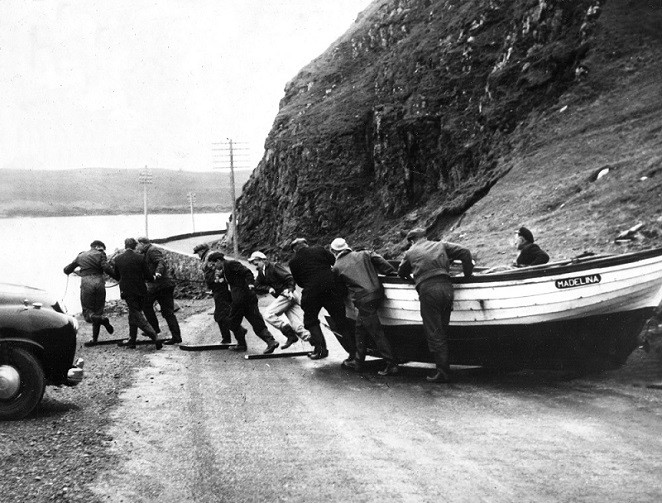Place Name of the Week - Grinds
Published: 24 September 2020
The dialect word grind comes from Old Norse grindr a wicket-gate, usually in a fence or wall. Grind place-names denote where there have been such gates or describe features that resemble gateways. Da Grind o da Navir at Eshaness is the gateway in the cliff where the powerful action of storm waves forces quarries out huge rocks and throws them up to form large heaps or storm beaches fifteen metres above sea level. Nafarr means an auger or gimlet, a tool for drilling holes.

Agnes Jamieson and daughter Betty of Houll, North Roe at the hill grind
(J D Rattar 1930s, Shetland Museum & Archives photo archive R03174)
Mavis Grind, the gateway to Northmavine, is from mæf-eiðs grind: gate of the narrow isthmus. Until the 1950s this isthmus was regularly used as a shortcut, with boats being hauled overland to avoid the long, and at times dangerous, journey around the north mainland. Sandy Johnson, my great-great grandfather, and his family used this crossing point when they relocated from Papa Stour to East Yell: “It was in February 1864 … they left Papa Stour before day light with two sixerns. One had 2 cows and as much fodder (corn and hay) as was supposed to feed them till grass came. And the other sixern had him and his wife and two bairns, the oldest a girl 3½ years and a boy (my husband) 13 months. They reached Mavisgrind and had to disload every thing and haul the sixerns across then load again, and reached the beach of Otterswick about 11pm”. (Shetland Archives D.9/319/2)

Hauling the Madelina (LK305) from the Atlantic Ocean to the North Sea across the crossing
point at Mavis Grind (J H McCulloch, Shetland Museum & Archives photo archive 03333)

John Smith closing the Wadbister hill grind, Bressay, late 1890s
(J M Smith, Shetland Museum & Archives photo archive G00064)
Hill daeks (dykes) were important boundary markers between township and the common grazing. The hill grind was the gate in the daek; a common type was the harr-hung grind where the main upright passed through a hole in a projecting wooden bar and the lower end pivoted in a hollow in a stone, as shown in the photo of the Wadbister hill grind, Bressay. Nearby crofts or houses often incorporated the word grind in their names - many are simply called Da Grind or Grinds. Other names include Mucklegrind, Voesgrind, Grindypoil, Grindabister and Grindalee. The latter house in Northavoe subsequently became Da Grinds and is now called Viewfield. Further examples are Gamlagrind, old gate; Grinderhoul and Grindwil, gate by the knowe; Grindategs, gate by the strip of land; Grindavelta, gate by the ploughed land; Stebbigrind, gate near the conical hill or rock; and the aptly named Windy Grind.

Voesgrind or East Booth at Sandwick Unst was a merchant house and böd built in
the first half of the 17th century
A few grind names have been anglicised to gate, such as Swinastigrind in West Burrafirth, now called Swinastigate. Gate names can however prove confusing - many of them are in fact gaets/getts, describing roads or paths. For more information about those names see my blog Gaets, gotts and veiens.
Eileen Brooke-Freeman
We hope you have enjoyed this blog.  We rely on the generous support of our funders and supporters to continue our work on behalf of Shetland. Everything we do is about caring for Shetland's outstanding natural and cultural heritage on behalf of the community and for future generations. Donations are welcomed and are essential to our work.
We rely on the generous support of our funders and supporters to continue our work on behalf of Shetland. Everything we do is about caring for Shetland's outstanding natural and cultural heritage on behalf of the community and for future generations. Donations are welcomed and are essential to our work.

